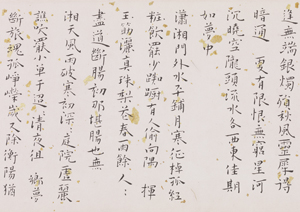Essay
This work was created on February 15, 1991, when Chang Ch’ung-ho was seventy-eight years old. That day was also the Chinese Lunar New Year. She made it for display in an international calligraphy exhibition in Japan. In this hanging scroll, she copies five ci (詞) poems composed by the Sothern Song poet, Jiang Kui (姜夔1154-1221) which describe Jiang’s feelings when traveling with friends.Refer to Jiang Baishi ci biannian jianjiao姜白石詞編年箋校 (Taipei: Zhonghua shuju, 1967): 3-5, 8-11, 13-15, 27, 35-36. Four of them were copied previously by Chang in her 1939 handscroll (Seattle Art Museum 20101.8.2). Therefore, the 1991 work provides a compelling later example of her small standard script, and by comparing the two scrolls—the 1939 handscroll and the 1991 hanging scroll—we are better able to understand the stylistic evolution of Chang Ch'ung-ho’s calligraphy.
In contrast to the 1939 work, each character in this hanging scroll is square and flat, with noticeably more angular turnings. The horizontal and na 捺strokes are done in the style of clerical script (lishu 隸書). The incorporation of clerical script shows the impact of prolonged exposure to and practice of calligraphy from ancient steles. Indeed, it was at the suggestion of her teacher Shen Yinmo 沈尹默 (1883–1971) that Chang diligently studied Han dynasty stele, which influenced her later calligraphy, often giving it an archaic flavor.Qianshen Bai, “Shen Yinmo yu Chang Ch’ung-ho” 沈尹默與張充和. In Shen Yinmo shuzhong moji沈尹默蜀中墨蹟: 13-14.
Secondly, the composition of this calligraphy offers an innovative approach to view small standard script, a script type rarely seen in hanging scrolls. The script privileges close-up, intimate viewing, and is therefore more suitable for handscroll and album formats rather than hanging scroll.Selected Works of Chang Ch’ung-ho’s Poetry, Calligraphy, and Painting: 138. By the same token, arranging four hundred small characters properly in the hanging scroll format poses an aesthetic challenge. Chang’s response was a tripartite composition. The central part consists of two poems, with one poem above the other; the uppermost poem in the center has the largest characters. The characters in both center poems are also larger than those either to their left or right. As a result, the hanging scroll has a pleasing composition, a poetic collage of fine calligraphy in small standard script.
© 2013 by the Seattle Art Museum
Questions for thought
Answers
| Add an answerAdd Answer:
overview
Chang Ch'ung-ho Frankel張充和
Quick Facts about the Artist
inscriptions and seals
essay
This work was created on February 15, 1991, when Chang Ch’ung-ho was seventy-eight years old. That day was also the Chinese Lunar New Year. She made it for display in an international calligraphy exhibition in Japan.
